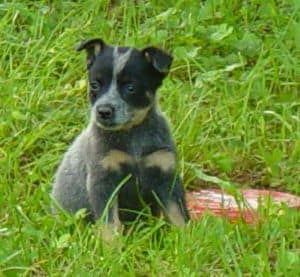
The Blue heeler rat terrier is a rare mixed-breed dog with a friendly disposition and medium-size build.
This dog is one of the results of the many Blue heeler breed crosses.
It’s the offspring of two purebred dogs; a rat terrier and a blue heeler which is also known as the Australian Cattle Dog.
As a hybrid dog, the rat terrier blue heeler is not yet a recognized dog breed.
Rat terrier blue heelers are not very common, and their genetic make-up is not yet defined and will vary greatly from dog to dog.
However, they tend to look more like miniature ACDs with a blend of characteristics from both parents.
The history of the blue heeler rat terrier hinges on that of their parents and to better understand this rare dog, we have to take a brief look at the history of the two purebred parents.
Meet The Parents: Brief history of the Rat terrier and the Blue heeler
Purebred Rat Terrier
The rat terrier is an American dog that was bred in the 1910s as a hunter and farm dog.
The rat terrier dog breed emerged when farmers were in dire need of a small dog that will tenaciously hunt down small farm pests, especially rodents.
Back in the beginning of the 20th century, a farmer’s worst enemy were small rodents that destroy crops and farm produce.
These pests had to be dealt with, and the solution came in the form of a compact and energetic small hunting dog with the speed of a Greyhound and the stamina and hunting instinct of a Terrier.
The Rat terrier was ultimately bred from crossing over seven dog breeds including the Smooth Fox Terrier, the now-extinct Old English White Terrier, Manchester Terrier, Bull Terrier, Whippet, Italian Greyhound, and Beagle.
As a vermin-hunter, the Rat terrier is strong on its feet with a muscular build, powerful shoulders and legs made for running after prey.
It’s an energetic and active dog breed with a cheerful and friendly disposition and an independent streak.
Purebred Blue Heeler (ACD)
The Australian Cattle Dog, also known as the Blue heeler or Queensland heeler, is a herding dog bred in the 19th century by the Australian settlers.
The ACD was originally used to herd cattle on large ranches, and they immensely contributed to the Australian beef market.
The ACD was bred to satisfy the ranchers need for a gentle but steadfast herding dog to quietly and efficiently drive cattle to the market without spooking them and causing a stampede.
After several cross-breeding between several dog breeds, the ACD was finally achieved.
The most desirable trait was the quiet herding style of the Blue heeler, instead of barking and scaring the wild stock, it gently nips their heels to get them moving.
The Blue heelers initial parents were Scottish Blue Merle Highland Collies crossed with native Australian wild Dingo dogs to produce the gentle Hall Heelers which were further bred with Dalmatians to introduce the “loyal” trait.
Further crosses were made with the Kelpies to instill endurance and working stamina. Finally, the Australian Cattle Dog emerged with a tenacity to quietly herd cattle, excellent working stamina and obedience to their masters.
With a mixture of these positive qualities, the ACD quickly gained popularity among Australian ranchers and became a recognized dog breed, and in 1980 it was accepted by the American Kennel Club.
Meet The Offspring: The Blue Heeler Rat Terrier
General Appearance
The Blue Terrier or Rat terrier blue heeler mix, is a strong, energetic and affectionate dog. It’s muscular and sturdy like the Blue Heeler but compact and alert like the Rat Terrier.
This dog has a medium-sized muscular body with strong shoulders and a powerful muzzle. Their ears are pricked and their oval-shaped eyes alert.
The Rat Terrier Blue Heeler usually has a short coat with a mixture of different colors; white, rusty red, and black.
Their coat will be primarily white with small dark speckles evenly distributed over their bodies, blotches of rusty red color are seen on their face, chest and limbs, while a significant portion of the face, especially around the eyes and ears will appear black.
Since this is a hybrid dog, the physical characteristics and personality traits are not yet defined, so you may find dogs with Blue Heeler and Rat Terrier parents who look just like one parent and some with a significantly different appearance.
Personality
Since the Blue heeler rat terrier is the offspring of two high-energy and hard-working dog breeds, you will expect it to show similar energy level and stamina.
And like their parents who are both known for their loyal, courageous, trustworthy and hardworking nature, these dogs will most certainly have the same traits.
The Blue heeler rat terrier is definitely a very active dog and can go on for hours without tiring out. This dog can be very playful and also strong-willed, it can handle pretty much anything, but beware that it needs to be trained and its energy needs to be properly channeled to avoid destruction.
A Blue terrier will need to be kept active to ensure it stays out of trouble, it’s not really a dog that will be okay with sitting around and doing nothing every day.
Rat terrier blue heelers also tend to be very alert with fast-moving legs and will not hesitate to chase down small prey or moving objects.
Like their ACD parents, these dogs have the tendency to nip, therefore they need to closely watched around kids.
Size And Life Expectancy of A Blue Heeler Rat Terrier
The Blue heeler rat terrier is a medium-sized dog that stands as tall as 13-18 inches at the shoulder and tips the scale at about 25 pounds. This dog has an average lifespan of 15 years.
Health Problems
A dog’s overall health, including inherited disorders, generally depends on that of its parents. For the Blue heeler rat terrier, both the Rat terrier and Blue heeler are generally healthy dogs, but like every other dog breed, they are also prone to certain health conditions that affect canines.
A Rat terrier blue heeler who has healthy parents will be a healthy dog, if you’re getting one of these dogs, make sure you ask for the health clearances of both puppy’s parents to ascertain that you have a healthy dog.
That aside, there are some canine conditions that this dog breed may be susceptible, and they include;
- Allergies: this is a common condition that plague dogs of all breeds and the Blue heeler rat terriers are no exception. You may find yourself with a dog who is allergic to some food types or some form of airborne allergy or contact dermatitis, which is a type of allergic reaction.
- Canine Hip Dysplasia: this is a condition where the thigh-bone does not properly fit into the hip joint. Some symptoms of this condition include pain or lameness on one or both hind legs, and it usually manifests much later in the dog’s life. Canine hip dysplasia is an inherited condition and the Blue Heelers have been known to show signs of this condition, therefore it can also affect their hybrid offspring.
- Incorrect Bite: this is the misalignment of the jaw bone, and it’s seen in certain dog breeds, including the Rat Terrier. This misalignment means that the teeth on the upper and lower jaws do not line up correctly when the mouth is closed. The condition will affect a dog’s bite and how they swallow, it can be corrected by surgery.
- Deafness: certain dog breeds have the tendency to lose their hearing as they age, and the Blue Heelers are unfortunately one of the breeds susceptible to deafness. This condition can also affect Blue Heeler crosses, including the Rat Terrier Blue Heeler.
Remember that not all Rat terrier blue heelers will suffer from any of these conditions. In fact, if the dog has healthy parents, then it would be healthy. However, it’s important that you know the possible health conditions in case you want to adopt one.
Blue Heeler Rat Terrier Care
The Blue Heeler Rat Terrier is not a dog suitable for apartments, he needs an environment with enough mental stimulation to keep home active. These dogs tend to thrive in country houses, farms, ranches and fenced homes with lots of open space for running around and expending energy.
Without the required daily stimulation and exercise, a Blue Heeler Rat Terrier may get destructive out of boredom. As a dog with herding and hurting parents, they get excited with moving objects including small animals, people, cars, balls, etc., and they will often give chase. These dogs crave activities and love challenges, including canine sports.
The Blue Heeler Rat Terrier’s only unpleasant trait is that it has a strong urge to nip and bite, even playfully. To overcome this natural nipping instinct, they need to be properly trained and socialized from a very young age.
Diet And Nutrition
Just like any other dog breed, Blue Heeler Rat Terriers need a balanced diet with the appropriate amount of nutrients, including vitamins and minerals. These dogs need a protein-rich diet and some great options include beef, salmon, chicken, pork, etc.
Whole grains and vegetables are also rich in carbohydrates, fiber, vitamins and essential minerals. The Blue Terriers diet will usually change at different stages in their life, especially as they move from pups to adults. A combination of dry kibbles, canned food and homemade dog meals will work well to give your dog all the necessary nutrients it needs.
Coat Color And Grooming
The Blue Terrier has a short coat with three a mixture of three colors; white, black and rusty red. Like its parents, it’s not a hypoallergenic dog and will often shed its coat seasonally. These dogs need moderate grooming, quick weekly brushing and occasional baths with an appropriate dog shampoo.
The frequency of coat brushing should be increased during shedding seasons to ensure all dead hair strands are removed. This dog’s nails should be trimmed at least once a month and their teeth should be brushed as often as possible, every day is ideal. Also ensure you check your Blue Terrier’s ears and dewax weekly to prevent ear infections.
Children And Other Pets
The Blue Heeler Rat Terrier may not be suitable for a home with young children and small pets because of their natural herding and hunting instincts. Their natural tendency to nip animals also transfers to nipping children, which can be scary for kids, and they always want to chase something. These dogs genuinely love people, and they can be almost hyperactive and always want to play or run around.
12 Blue Heeler Terrier Mixes
I think it is fair to say that the Blue Heeler Rat Terrier mix is the most common Blue Heeler and Terrier cross breed of dog.
But the Rat Terrier isn’t the only terrier that is bred with a Blue Heeler.
After all, the AKC (American Kennel Club) recognise thirty one different types of terriers.
So this got me thinking…
How many other blue heeler terrier mixes could I find?
And so, I went digging.
And what do you know?
Out of a possible thirty one mixes, I found photographic evidence of thirteen blue heeler terrier mixes.
And the mixes I could find were:
- Blue Heeler Jack Russell mix
- Blue Heeler Staffordshire Terrier mix
- Blue Heeler Pitbull Terrier mix
- Blue Heeler Boston Terrier mix
- Blue Heeler Airedale mix
- Blue Heeler Border Terrier mix
- Blue Heeler Bull Terrier mix
- Blue Heeler Cairn Terrier mix
- Blue Heeler Fox Terrier mix
- Blue Heeler Irish Terrier mix
- Blue Heeler Manchester Terrier mix
- Blue Heeler Miniature Schnauzer mix
And if you don’t believe me just type any of those terrier mixes into Google and you will be able to find a genuine photo from a site such as Pinterest or an rescue dog organisation.
Closing Thoughts
The Rat terrier blue heeler is a very active and intelligent dog, and with proper training it can be a great family dog. But since it’s an uncommon dog, you may not easily find one in your local animal shelters or rescue groups. If you decide to adopt a Blue heeler rat terrier, make sure you do enough research to ascertain that the dog is from healthy parents and ask to see to the health clearances of both puppy’s parents. Adopting puppies from reputable breeders and rescue groups also increases your chances of getting a healthy dog. Finding a Blue heeler rat terrier mix may not be very easy, but with any luck, you can find one for your home.





